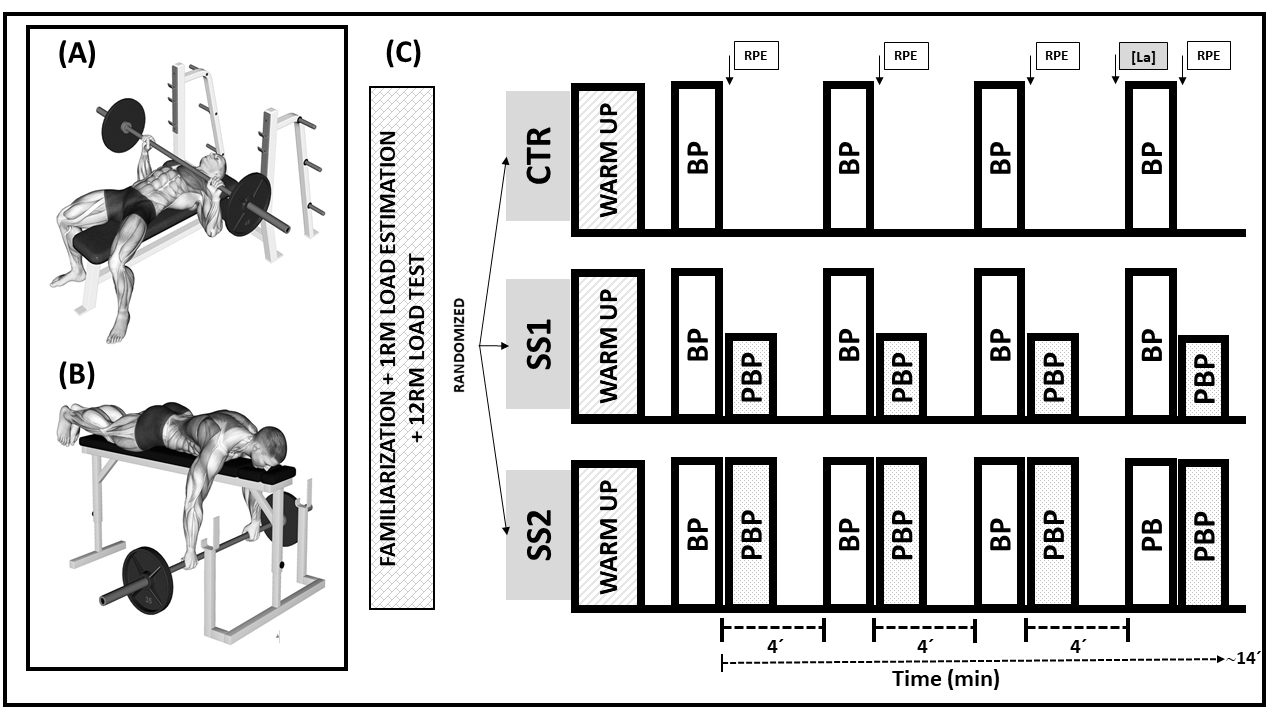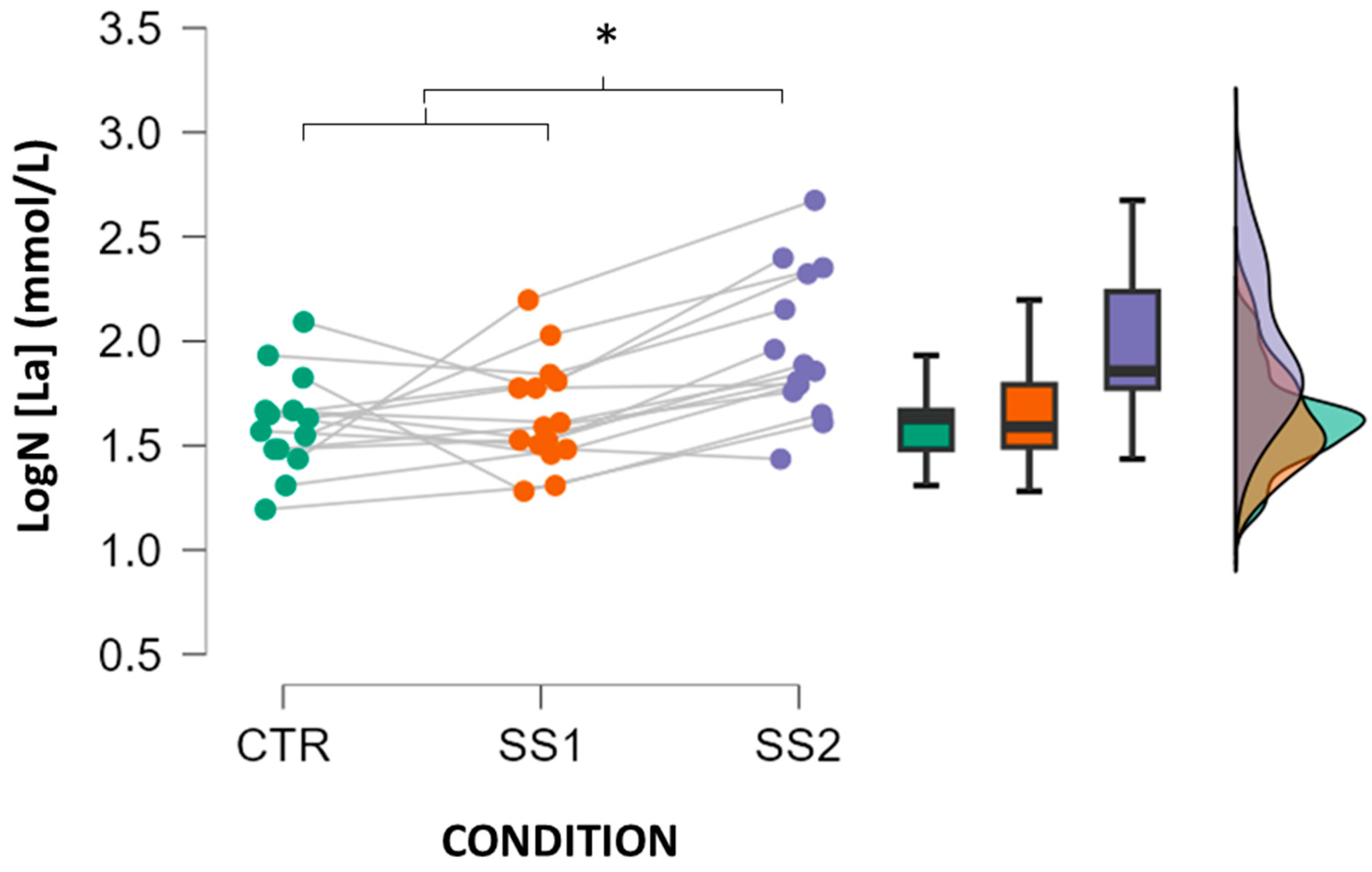Effects of Varying Antagonist Exercise Volume in Upper-Body Supersets on Mechanical, Metabolic, and Perceptual Responses in Resistance-Trained Men
Abstract
1. Introduction
2. Materials and Methods
2.1. Participants
2.2. Experimental Design
2.3. Procedures
2.3.1. Preliminary Session
2.3.2. Experimental Sessions
2.3.3. Assessment of Mechanical, Metabolic and Perceptual Variables
2.4. Statistical Analysis
3. Results
3.1. Baseline Wellness
3.2. Reliability of BP Velocity Measures
3.3. Mechanical Performance During Agonist Exercise (BP)
3.4. Ratings of Perceived Exertion (RPE)
3.5. Blood Lactate Concentration [La]
3.6. Mechanical Performance During Antagonist Exercise (PBP)
4. Discussion
5. Conclusions
Author Contributions
Funding
Institutional Review Board Statement
Informed Consent Statement
Data Availability Statement
Acknowledgments
Conflicts of Interest
References
- Ratamess, N.; Alvar, B.; Evetoch, T.; Housh, T.; Kibler, W.; Kraemer, W.J.; Triplett, N.T.; American College of Sports Medicine. Progression models in resistance training for healthy adults. Med. Sci. Sports Exerc. 2009, 41, 687–708. [Google Scholar] [CrossRef]
- Kraemer, W.J.; Ratamess, N.A. Fundamentals of resistance training: Progression and exercise prescription. Med. Sci. Sports Exerc. 2004, 36, 674–688. [Google Scholar] [CrossRef]
- Suchomel, T.J.; Nimphius, S.; Stone, M.H. The importance of muscular strength in athletic performance. Sports Med. 2016, 46, 1419–1449. [Google Scholar]
- Schoenfeld, B.J. The mechanisms of muscle hypertrophy and their application to resistance training. J. Strength Cond. Res. 2010, 24, 2857–2872. [Google Scholar] [CrossRef]
- Schoenfeld, B.J.; Grgic, J.; Van Every, D.W.; Plotkin, D.L. Loading recommendations for muscle strength, hypertrophy, and local endurance: A re-examination of the repetition continuum. Sports 2021, 9, 32. [Google Scholar] [CrossRef]
- Ekkekakis, P.; Parfitt, G.; Petruzzello, S.J. The pleasure and displeasure people feel when they exercise at different intensities: Decennial update and progress towards a tripartite rationale for exercise intensity prescription. Sports Med. 2011, 41, 641–671. [Google Scholar] [CrossRef]
- Robbins, D.W.; Young, W.B.; Behm, D.G.; Payne, W.R. Agonist-antagonist paired set resistance training: A brief review. J. Strength Cond. Res. 2010, 24, 2873–2882. [Google Scholar] [CrossRef] [PubMed]
- Paz, G.A.; de Freitas Maia, M.; Miranda, H.; de Castro, J.B.P.; Willardson, J.M. Maximal strength performance, efficiency, and myoelectric responses with differing intra-set rest intervals during paired set training. J. Bodyw. Mov. Ther. 2020, 24, 263–268. [Google Scholar] [CrossRef] [PubMed]
- Weakley, J.J.S.; Till, K.; Read, D.B.; Roe, G.A.B.; Darrall-Jones, J.; Phibbs, P.J.; Jones, B. The effects of traditional, superset, and tri-set resistance training structures on perceived intensity and physiological responses. Eur. J. Appl. Physiol. 2017, 117, 1877–1889. [Google Scholar] [CrossRef] [PubMed]
- Zhang, X.; Weakley, J.; Li, H.; Li, Z.; García-Ramos, A. Superset Versus Traditional Resistance Training Prescriptions: A Systematic Review and Meta-Analysis Exploring Acute and Chronic Effects on Mechanical, Metabolic, and Perceptual Variables. Sports Med. 2025, 55, 953–975. [Google Scholar] [CrossRef]
- Bentes, C.M.; Simão, R.; Bunker, T.; Rhea, M.R.; Miranda, H.; Gomes, T.M.; Novaes, J.d.S. Acute effects of dropsets among different resistance training methods in upper body performance. J. Hum. Kinet. 2012, 34, 105–111. [Google Scholar] [CrossRef] [PubMed]
- González-Badillo, J.J.; Sánchez-Medina, L. Movement velocity as a measure of loading intensity in resistance training. Int. J. Sports Med. 2010, 31, 347–352. [Google Scholar] [CrossRef]
- Weakley, J.; Mann, B.; Banyard, H.; McLaren, S.; Scott, T.; Garcia-Ramos, A. Velocity-Based Training: From Theory to Application. Strength. Cond. J. 2021, 43, 31–49. [Google Scholar] [CrossRef]
- González-Badillo, J.J.; Yañez-García, J.M.; Mora-Custodio, R.; Rodríguez-Rosell, D. Velocity Loss as a Variable for Monitoring Resistance Exercise. Int. J. Sports Med. 2017, 38, 217–225. [Google Scholar] [CrossRef]
- Flanagan, E.; Jovanović, M. Researched Applications of Velocity Based Strength Training. J. Aust. Strength Cond. 2014, 22, 58–69. [Google Scholar]
- Robertson, R.J.; Goss, F.L.; Rutkowski, J.; Lenz, B.; Dixon, C.; Timmer, J.; Frazee, K.; Dube, J.; Andreacci, J. Concurrent validation of the OMNI perceived exertion scale for resistance exercise. Med. Sci. Sports Exerc. 2003, 35, 333–341. [Google Scholar] [CrossRef] [PubMed]
- Sánchez-Medina, L.; González-Badillo, J.J.; Pérez, C.E.; Pallarés, J.G. Velocity- and power-load relationships of the bench pull vs. bench press exercises. Int. J. Sports Med. 2014, 35, 209–216. [Google Scholar] [CrossRef]
- Janicijevic, D.; Jukic, I.; Weakley, J.; García-Ramos, A. Bench Press 1-Repetition Maximum Estimation Through the Individualized Load–Velocity Relationship: Comparison of Different Regression Models and Minimal Velocity Thresholds. Int. J. Sports Physiol. Perform. 2021, 16, 1074–1081. [Google Scholar] [CrossRef]
- García-Ramos, A.; Barboza-González, P.; Ulloa-Díaz, D.; Rodriguez-Perea, A.; Martinez-Garcia, D.; Guede-Rojas, F.; Hinojosa-Riveros, H.; Chirosa-Ríos, L.J.; Cuevas-Aburto, J.; Janicijevic, D.; et al. Reliability and validity of different methods of estimating the one-repetition maximum during the free-weight prone bench pull exercise. J. Sports Sci. 2019, 37, 2670–2679. [Google Scholar] [CrossRef]
- Hooper, S.L.; Mackinnon, L.T.; Howard, A.; Gordon, R.D.; Bachmann, A.W. Markers for monitoring overtraining and recovery. Med. Sci. Sports Exerc. 1995, 27, 106–112. [Google Scholar] [CrossRef]
- Márquez, G.; Romero-Arenas, S.; Marín-Pagán, C.; Vera-Ibañez, A.; Fernández Del Olmo, M.; Taube, W. Peripheral and central fatigue after high intensity resistance circuit training. Muscle Nerve 2017, 56, 152–159. [Google Scholar] [CrossRef]
- Goodwin, M.L.; Harris, J.E.; Hernández, A.; Gladden, L.B. Blood lactate measurements and analysis during exercise: A guide for clinicians. J. Diabetes Sci. Technol. 2007, 1, 558–569. [Google Scholar] [CrossRef]
- Paz, G.A.; Maia, M.F.; Salerno, V.P.; Coburn, J.; Willardson, J.M.; Miranda, H. Neuromuscular responses for resistance training sessions adopting traditional, superset, paired set and circuit methods. J. Sports Med. Phys. Fitness 2019, 59, 1991–2002. [Google Scholar] [CrossRef]
- Paz, G.A.; Robbins, D.W.; de Oliveira, C.G.; Bottaro, M.; Miranda, H. Volume Load and Neuromuscular Fatigue During an Acute Bout of Agonist-Antagonist Paired-Set vs. Traditional-Set Training. J. Strength Cond. Res. 2017, 31, 2777–2784. [Google Scholar] [CrossRef]
- González-Hernández, J.M.; García-Ramos, A.; Colomer-Poveda, D.; Tvarijonaviciute, A.; Cerón, J.; Jiménez-Reyes, P.; Márquez, G. Resistance training to failure vs. not to failure: Acute and delayed markers of mechanical, neuromuscular, and biochemical fatigue. J. Strength Cond. Res. 2021, 35, 886–893. [Google Scholar] [CrossRef] [PubMed]
- Weakley, J.J.S.; Till, K.; Read, D.B.; Phibbs, P.J.; Roe, G.; Darrall-Jones, J.; Jones, B.L. The effects of superset configuration on kinetic, kinematic, and perceived exertion in the barbell bench press. J. Strength Cond. Res. 2020, 34, 65–72. [Google Scholar] [CrossRef] [PubMed]
- Robbins, D.W.; Young, W.B.; Behm, D.G. The effect of an upper-body agonist–antagonist resistance training protocol on volume load and efficiency. J. Strength Cond. Res. 2010, 24, 2632–2640. [Google Scholar] [CrossRef]
- Corrêa Neto, V.G.; Silva, D.D.N.; Palma, A.; de Oliveira, F.; Vingren, J.L.; Marchetti, P.H.; da Silva Novaes, J.; Monteiro, E.R. Comparison between traditional and alternated resistance exercises on blood pressure, acute neuromuscular responses, and rating of perceived exertion in recreationally resistance-trained men. J. Strength Cond. Res. 2024, 38, e211–e218. [Google Scholar] [CrossRef]
- Zhao, H.; Yamaguchi, S.; Okada, J. Effects of rest interval array on training volume, perceived exertion, neuromuscular fatigue, and metabolic responses during agonist-antagonist muscle alternative training. J. Sports Med. Phys. Fitness 2020, 60, 536–543. [Google Scholar] [CrossRef] [PubMed]
- Kelleher, A.R.; Hackney, K.J.; Fairchild, T.J.; Keslacy, S.; Ploutz-Snyder, L.L. The metabolic costs of reciprocal supersets vs. traditional resistance exercise in young recreationally active adults. J. Strength Cond. Res. 2010, 24, 1043–1051. [Google Scholar] [CrossRef]
- Pareja-Blanco, F.; Rodríguez-Rosell, D.; Sánchez-Medina, L.; Sanchis-Moysi, J.; Dorado, C.; Mora-Custodio, R.; Yáñez-García, J.M.; Morales-Alamo, D.; Pérez-Suárez, I.; Calbet, J.A.L.; et al. Effects of velocity loss during resistance training on athletic performance, strength gains and muscle adaptations. Scand. J. Med. Sci. Sports 2017, 27, 724–735. [Google Scholar] [CrossRef] [PubMed]


| Variable | CTR | SS1 | SS2 | Χ2 (Friedman) | p |
|---|---|---|---|---|---|
| Sleep quality (a.u.) | 7.13 ± 1.06 | 7.13 ± 1.25 | 6.47 ± 1.85 | 2.44 | 0.295 |
| Fatigue (a.u.) | 3.47 ± 1.25 | 3.73 ± 1.62 | 3.93 ± 1.91 | 2.33 | 0.312 |
| Muscular pain (a.u.) | 3.47 ± 2.36 | 3.13 ± 1.96 | 3.13 ± 1.77 | 0.81 | 0.668 |
| Stress (a.u.) | 3.07 ± 1.83 | 3.07 ± 2.05 | 3.20 ± 2.01 | 0.84 | 0.656 |
| Variable | Condition | SET1 | SET2 | SET3 | SET4 |
|---|---|---|---|---|---|
| MSV (m·s−1) | CTR | 0.549 ± 0.133 | 0.537 ± 0.127 | 0.527 ± 0.141 a | 0.510 ± 0.119 b |
| SS1 | 0.606 ± 0.148 | 0.548 ± 0.139 | 0.542 ± 0.137 a | 0.530 ± 0.131 b | |
| SS2 | 0.564 ± 0.142 | 0.536 ± 0.145 | 0.529 ± 0.132 a | 0.520 ± 0.132 b | |
| Vfastest (m·s−1) | CTR | 0.620 ± 0.156 | 0.614 ± 0.159 | 0.623 ± 0.170 | 0.594 ± 0.144 |
| SS1 | 0.648 ± 0.160 | 0.640 ± 0.163 | 0.644 ± 0.169 | 0.626 ± 0.145 | |
| SS2 | 0.653 ± 0.179 | 0.633 ± 0.169 | 0.619 ± 0.144 | 0.611 ± 0.160 |
| Condition | SET1 | SET2 | SET3 | SET4 |
|---|---|---|---|---|
| CTR ( a.u.) | 5.79 ± 0.89 | 6.29 ± 1.07 | 6.57 ± 1.28 a | 6.57 ± 1.02 b,c |
| SS1 ( a.u.) | 5.93 ± 1.33 | 6.50 ± 1.16 | 6.64 ± 1.28 a | 7.00 ± 1.24 b,c |
| SS2 ( a.u.) | 5.79 ± 0.89 | 6.14 ± 1.17 | 6.64 ± 0.93 a | 7.14 ± 1.23 b,c |
| Variable | Condition | SET 1 | SET 2 | SET 3 | SET 4 |
|---|---|---|---|---|---|
| MSV (m·s−1) | SS1 | 0.807 ± 0.174 | 0.816 ± 0.171 | 0.806 ± 0.159 | 0.820 ± 0.186 |
| SS2 | 0.764 ± 0.176 a | 0.757 ± 0.168 a | 0.761 ± 0.167 a | 0.734 ± 0.151 a | |
| Vfastest (m·s−1) | SS1 | 0.856 ± 0.184 | 0.865 ± 0.181 | 0.856 ± 0.163 | 0.868 ± 0.190 |
| SS2 | 0.849 ± 0.196 | 0.856 ± 0.181 | 0.873 ± 0.186 | 0.840 ± 0.152 |
Disclaimer/Publisher’s Note: The statements, opinions and data contained in all publications are solely those of the individual author(s) and contributor(s) and not of MDPI and/or the editor(s). MDPI and/or the editor(s) disclaim responsibility for any injury to people or property resulting from any ideas, methods, instructions or products referred to in the content. |
© 2025 by the authors. Licensee MDPI, Basel, Switzerland. This article is an open access article distributed under the terms and conditions of the Creative Commons Attribution (CC BY) license (https://creativecommons.org/licenses/by/4.0/).
Share and Cite
Márquez, G.; Coutado-Sánchez, E.; Villaraviz-Ferro, A.; Marcos-Frutos, D.; García-Ramos, A.; Colomer-Poveda, D. Effects of Varying Antagonist Exercise Volume in Upper-Body Supersets on Mechanical, Metabolic, and Perceptual Responses in Resistance-Trained Men. J. Funct. Morphol. Kinesiol. 2025, 10, 419. https://doi.org/10.3390/jfmk10040419
Márquez G, Coutado-Sánchez E, Villaraviz-Ferro A, Marcos-Frutos D, García-Ramos A, Colomer-Poveda D. Effects of Varying Antagonist Exercise Volume in Upper-Body Supersets on Mechanical, Metabolic, and Perceptual Responses in Resistance-Trained Men. Journal of Functional Morphology and Kinesiology. 2025; 10(4):419. https://doi.org/10.3390/jfmk10040419
Chicago/Turabian StyleMárquez, Gonzalo, Etham Coutado-Sánchez, Adrián Villaraviz-Ferro, Daniel Marcos-Frutos, Amador García-Ramos, and David Colomer-Poveda. 2025. "Effects of Varying Antagonist Exercise Volume in Upper-Body Supersets on Mechanical, Metabolic, and Perceptual Responses in Resistance-Trained Men" Journal of Functional Morphology and Kinesiology 10, no. 4: 419. https://doi.org/10.3390/jfmk10040419
APA StyleMárquez, G., Coutado-Sánchez, E., Villaraviz-Ferro, A., Marcos-Frutos, D., García-Ramos, A., & Colomer-Poveda, D. (2025). Effects of Varying Antagonist Exercise Volume in Upper-Body Supersets on Mechanical, Metabolic, and Perceptual Responses in Resistance-Trained Men. Journal of Functional Morphology and Kinesiology, 10(4), 419. https://doi.org/10.3390/jfmk10040419










